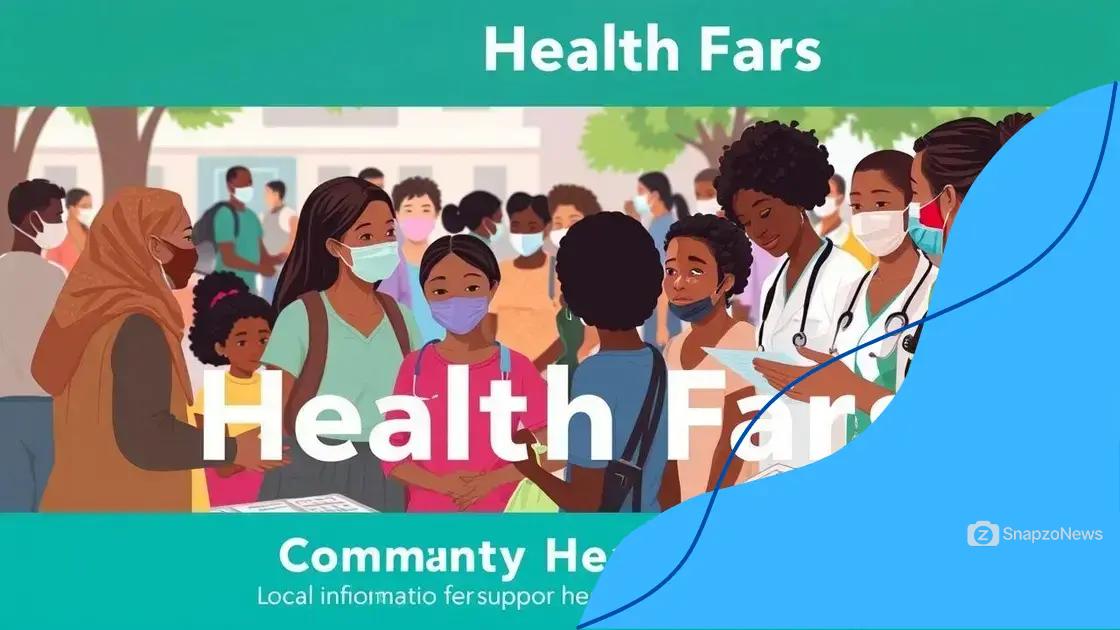Reducing healthcare inequalities in marginalized areas

Reducing healthcare inequalities in marginalized areas involves implementing inclusive policies, leveraging technology, and engaging communities to ensure equitable access to quality healthcare for all individuals.
Reducing healthcare inequalities in marginalized areas is essential for ensuring that everyone has access to the healthcare they need. Have you ever wondered how these disparities affect real lives? Let’s dive into the topic and explore potential solutions together.
Understanding healthcare inequalities
Understanding healthcare inequalities is vital for promoting fairness in medical services. Different factors contribute to these disparities, affecting many people’s access to necessary care.
Key Factors Contributing to Inequalities
Several elements play a critical role in creating healthcare inequalities: availability, affordability, and cultural acceptance. Recognizing these factors can help us address them effectively.
- Geographic location: People in rural areas often face significant challenges in accessing healthcare facilities compared to those in urban regions.
- Socioeconomic status: Individuals with lower income often can’t afford medical insurance or out-of-pocket expenses.
- Cultural barriers: Language differences or cultural misunderstandings can hinder individuals from receiving appropriate care.
- Education levels: Limited health literacy can prevent people from effectively navigating the healthcare system.
Moreover, race and ethnicity can play a role in how individuals experience healthcare. For instance, studies show that certain minority groups often receive lower quality services and face discrimination. This can lead to poorer health outcomes compared to their counterparts.
It’s essential to note that healthcare inequalities don’t only affect the underserved populations. They can strain communities and increase healthcare costs for everyone. When people can’t access timely care, it can lead to more severe medical issues, ultimately resulting in higher expenses for the healthcare system.
Addressing the Inequities
To combat healthcare inequalities, we must analyze the data, recognize at-risk populations, and implement effective solutions. Collaboration between healthcare providers, policymakers, and community organizations is key.
Incorporating technology can also bridge gaps. Telehealth services are an excellent example of how healthcare can expand reach. By offering virtual consultations, we can bring services to remote and underserved locations. This can enhance access significantly and improve overall health outcomes.
Impact of socio-economic factors on health
The impact of socio-economic factors on health is significant and multi-faceted. Many people may not realize how much their surroundings influence their well-being. Various elements, such as income and education, play enormous roles in determining health outcomes.
Key Socio-Economic Factors
Some of the most influential socio-economic factors include:
- Income level: Higher income generally allows for better access to healthcare and healthier living conditions.
- Education: Greater educational attainment often leads to a better understanding of health issues and available resources.
- Employment status: Job stability can provide health insurance and access to necessary medical care.
- Living environment: Communities with clean water, nutritious food options, and safe housing contribute positively to health.
These factors often combine, creating a chain reaction that affects physical and mental health. For example, a person with a low income might struggle to obtain adequate healthcare, which can lead to untreated conditions. This, in turn, can affect their ability to work and secure a better income, creating a cycle of poor health and poverty.
Cultural Influences
Cultural beliefs also play a role in how individuals perceive healthcare. In some communities, people may avoid seeking medical attention due to stigma or misinformation. Understanding these cultural perspectives is crucial for providing effective healthcare services.
Additionally, social support systems can greatly affect health outcomes. Individuals with strong networks of family and friends often cope better with stress and illness. Conversely, those who lack such support may experience worse health outcomes. The connection between social ties and health can’t be underestimated.
Community efforts to improve access

Community efforts to improve access to healthcare are vital for addressing healthcare inequalities. Many communities recognize the barriers faced by their members and work collaboratively to create solutions. These local initiatives often have a significant impact on enhancing health outcomes.
Examples of Community Initiatives
There are various programs that seek to make healthcare services more accessible:
- Mobile health clinics: These clinics travel to underserved areas, providing essential services like vaccinations, screenings, and health education.
- Community health workers: Trained residents can offer resources and support while aiding individuals in navigating the healthcare system.
- Health fairs: Local events can raise awareness about health resources, offering free check-ups and informational sessions.
- Partnerships with local organizations: Collaborating with schools and faith-based organizations can help identify and reach those most in need.
Such community-driven efforts rely on the active participation of residents. When people come together, they can share knowledge and resources. This collaboration creates a stronger support network that empowers individuals to take charge of their health.
Promoting Health Education
Another important aspect of community efforts is promoting health education. Providing information about nutrition, exercise, and preventive care can better equip individuals to manage their health. Education can significantly relieve pressure on healthcare systems by encouraging healthier behaviors.
Additionally, communities can advocate for policy changes that lead to broader access to healthcare services. By engaging local officials and decision-makers, residents can emphasize the importance of developing policies that benefit their communities. This proactive approach ensures that health concerns are addressed effectively, putting the needs of the people first.
Technological solutions for marginalized areas
Technological solutions for marginalized areas are crucial in addressing healthcare inequalities. Technology has the potential to bridge gaps and provide essential services to those who need them the most. By incorporating innovative tools, communities can enhance healthcare access and improve overall health outcomes.
Telehealth Services
One of the most impactful technological advancements is telehealth. This approach allows patients to consult with healthcare providers remotely, saving time and resources. Here are some key benefits of telehealth:
- Increased accessibility: Patients in remote areas can receive care without traveling long distances.
- Reduced waiting times: Telehealth can decrease the time needed for appointments, leading to quicker access to care.
- Cost-effective: Virtual visits often lower overall healthcare costs for patients and providers.
- Enhanced patient monitoring: Remote monitoring tools can help track health metrics, ensuring timely interventions when necessary.
By tapping into telehealth services, marginalized communities can overcome barriers to accessing health care, receiving timely medical advice and support.
Mobile Health Applications
Mobile health applications, or mHealth, are another valuable resource. These apps can offer health education, medication reminders, and tools for tracking health metrics. They empower individuals to take charge of their health, promoting preventive care and early intervention.
Furthermore, social media platforms can also play a vital role in disseminating health information. Engaging communities through these platforms can raise awareness of available resources and encourage healthy behaviors. Direct communication helps build trust and fosters a supportive environment.
Finally, using data analytics can inform public health decisions in these areas. By collecting and analyzing data about health trends, communities can better allocate resources and address specific needs. This proactive approach allows for targeted interventions that can significantly improve health outcomes.
Policy changes for healthcare equity
Policy changes for healthcare equity are essential for creating a fair healthcare system. Effective policies can reduce healthcare inequalities and ensure that everyone has access to the services they need. This involves addressing the root causes of disparities that affect marginalized communities.
Importance of Inclusive Policies
Inclusive policy changes encompass a range of factors, including access, affordability, and quality of care. When developing new policies, officials must prioritize equity. This approach helps create a system where everyone can thrive.
- Universal coverage: Implementing policies that guarantee access to healthcare services for all individuals is crucial. This may include expanding existing programs or creating new ones.
- Financial assistance: Providing subsidies or support for low-income families can alleviate the costs associated with healthcare, making it more attainable.
- Workforce development: Training and recruiting healthcare providers in underserved areas can directly impact the availability of services.
- Culturally competent care: Policies should promote training for healthcare professionals to understand and respect the diverse backgrounds of their patients.
In addition to these factors, local governments can engage community members in the policy-making process. By listening to those affected by healthcare inequalities, officials can make informed decisions that address specific needs. This collaboration fosters trust and ensures that policies are relevant and effective.
Advocating for Change
Advocacy plays a significant role in promoting healthcare equity. Grassroots organizations and community leaders can push for reforms that address inequities in the system. By raising awareness and mobilizing community members, they create a collective voice that cannot be ignored.
Effective advocacy can lead to changes at the legislative level. When policymakers understand the impact of healthcare inequalities, they may be more willing to support relevant initiatives. Continuous pressure and communication are needed to keep these issues at the forefront of public discourse.
FAQ – Frequently Asked Questions about Reducing Healthcare Inequalities in Marginalized Areas
What are healthcare inequalities?
Healthcare inequalities refer to the differences in access to health services and the quality of care received by different populations, often influenced by socio-economic factors.
How can technology help improve healthcare access?
Technology such as telehealth and mobile health applications can bridge gaps by providing remote access to healthcare services and resources, making them more accessible to underserved communities.
Why is community engagement important in healthcare?
Community engagement fosters trust and cooperation, ensuring that health initiatives reflect the needs and preferences of the population, leading to better health outcomes.
What role do policies play in achieving healthcare equity?
Policies that promote healthcare equity help ensure fair access to services, support affordability, and encourage the training of healthcare workers in marginalized areas.
